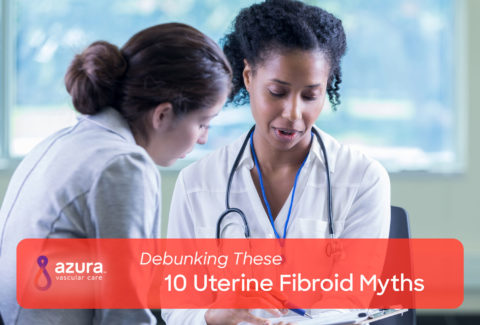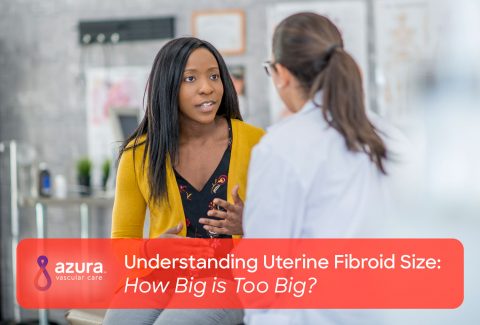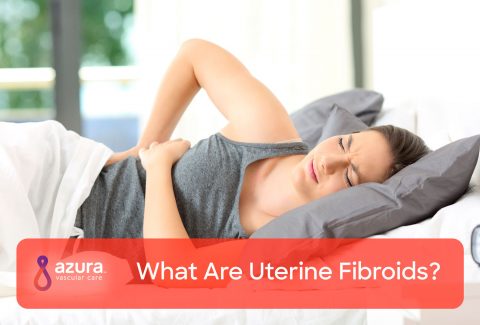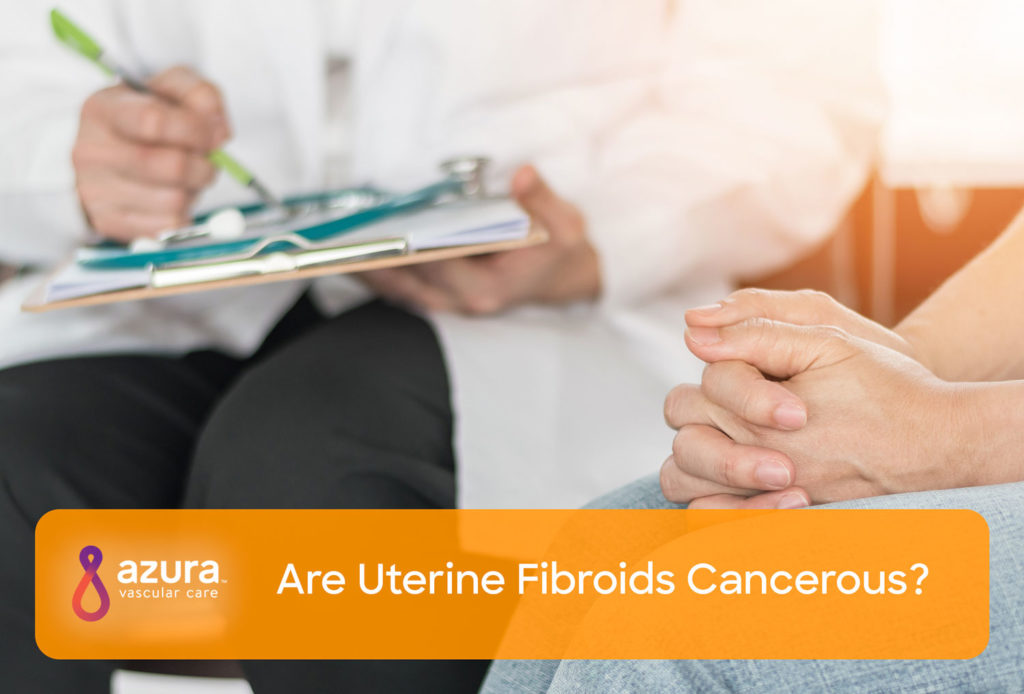
If you’ve recently been diagnosed with uterine fibroids, you probably have many questions. Your first concern may be, “Are fibroids cancerous?” or “Do fibroids cause cancer?” Fortunately, the answer is usually no, but fibroids can still have a significant impact on your health and lifestyle. Uterine fibroids and uterine cancer may also share certain risk factors. (i, ii) Read on to learn more.
What Are Uterine Fibroids?
Uterine fibroids are tumors that develop in or around the uterus. These growths are typically benign. The size, shape, location and number of fibroids can vary. You might only have one fibroid, or you might have several. (i)
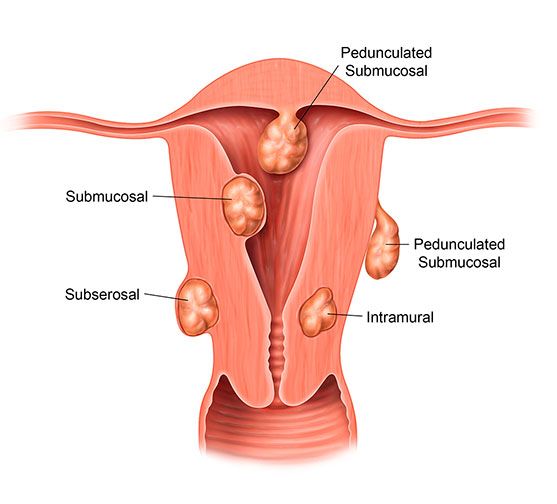
Fibroids may not cause any noticeable symptoms. Many women with fibroids enjoy excellent health. But others can experience heavy bleeding, pelvic pain, or other troubling symptoms that may lead to embarrassing social situations. (i)
Uterine fibroids occasionally cause fertility issues. Not all women with fibroids have difficulty becoming or staying pregnant, but some types of fibroids can cause infertility or miscarriage. (i)
Are Fibroids Cancerous?
Do fibroids cause cancer? Generally, no. Most fibroids are benign, and there is no evidence that having fibroids increases your risk of uterine cancer. (iii)
In rare cases, though, fibroids may contain cancerous cells. If you’re at a high risk for uterine cancer, your obstetrician-gynecologist (OBGYN) may recommend a biopsy of your fibroids to check for cancer.
Do Fibroids Cause Cancer?
There is no direct cause-and-effect relationship between fibroids and cancer. (iii) The same genetic or lifestyle factors that increase your risk for fibroids might also increase your risk for uterine cancer. (i)(ii)
But you can control many risk factors with proper medical care and a healthy lifestyle. Eating a nutritious diet and getting enough exercise can lower your cancer risk. Regular exams and screenings also help diagnose cancer when it’s still treatable. (vi)
How Can I Help Keep My Uterus Healthy?
Women who are overweight or obese are at a higher risk for fibroids. Obesity is also a significant risk factor for many types of cancer, including uterine cancer. (ii) If you’re overweight, you may need to discuss lifestyle changes with your doctor.
Poor diet can increase your risk of both fibroids and cancer. It’s best to avoid heavy alcohol consumption and reduce red meat intake. Eating plenty of fruits, vegetables, and legumes can help protect against many gynecological health problems. (ii)
Smoking also increases your risk for many types of cancer, including uterine cancer. (vii) If you’re taking hormone medications like birth control pills, smoking can also put you at risk for blood clots or strokes. (viii) It’s always safest to avoid tobacco products.
Symptoms of Uterine Fibroids
Common signs and symptoms of uterine fibroids can include: (i)
- Heavy menstrual periods
- Periods that last longer than a week
- Pelvic or lower abdominal pain
- Difficulty emptying your bladder
- Frequent urination
- Constipation
- Lower back pain
If you have any fibroid symptoms, report them to your OBGYN right away. Fibroids are not life-threatening, but uterine cancer is sometimes mistaken for fibroids in its early stages. (v) If you do have cancer, early detection is critical for preserving your health and fertility.
What Causes Uterine Fibroids?
Doctors aren’t sure what causes uterine fibroids. They seem to be linked to specific environmental and genetic risk factors. Many of the risk factors for fibroids are the same as those for uterine cancer. (i)(ii)
Increased levels of estrogen seem to boost a woman’s risk of developing fibroids. Girls and women who are not menstruating are usually at a low risk for fibroids. (iii)
However, taking hormonal medications that contain estrogen may increase your chances of developing fibroids or certain cancers. (ii, vi) Not all hormone medications are risky. Drugs that contain both progesterone and estrogen, including most birth control pills, may even lower your risk of uterine cancer, but drugs that contain estrogen alone could increase your risk of fibroids or cancer. (ii)
Before taking hormone medications, be sure to ask your doctor about the risks and benefits of these drugs.
How Are Fibroids Diagnosed?
Large fibroids are sometimes detected during a pelvic exam. If your doctor notices any unusual masses in your pelvic area, he or she may perform an ultrasound to confirm the diagnosis. (iii)
Most fibroids can be accurately diagnosed during an abdominal or transvaginal ultrasound. But in some cases, you may need other imaging tests like an X-ray, MRI, or CT scan. (iii)
Understanding Your Treatment Options
Not all fibroids need to be treated. (ix) With small, asymptomatic fibroids, the risks of treatment may outweigh the benefits. If your fibroids are causing painful symptoms or fertility problems, however, treatment may be necessary.
In the past, doctors often recommended hysterectomy as a first-line treatment for uterine fibroids. In recent years, that recommendation has changed. Minimally invasive and noninvasive procedures are available options for treating many fibroids.
Uterine fibroids embolization (UFE) is an excellent option for many patients. This procedure is performed on an outpatient basis under local anesthesia. UFE requires only a tiny incision, so there’s little risk of scarring or infection. Recovery time is usually short. Best of all, UFE preserves your uterus so patients can avoid the physical and emotional trauma of a hysterectomy. (x)
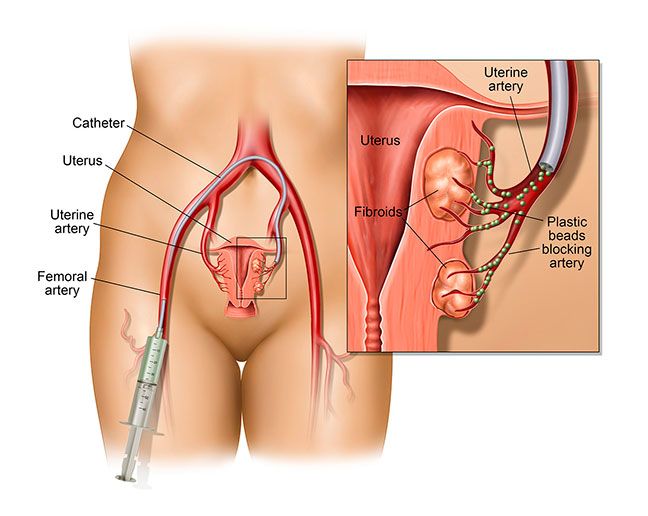
At Azura Vascular Care, UFE is performed by a highly trained vascular specialist. Azura Vascular Care offers a safe, comfortable, fully equipped setting with an experienced staff who provide top-quality follow-up care.
Ready to learn more about UFE? Download our free information sheet, Understanding Uterine Fibroid Embolization (UFE), or call 844-UFE-CARE (833-2273) today to schedule an appointment with a vascular specialist.
Sources:
(i) Mayo Clinic. (2018, March 6). Uterine fibroids: Symptoms & causes. Retrieved December 7, 2018, from https://www.mayoclinic.org/diseases-conditions/uterine-fibroids/symptoms-causes/syc-20354288.
(ii) American Cancer Society. (2016, February 29). Endometrial cancer risk factors. Retrieved December 9, 2018, from https://www.cancer.org/cancer/endometrial-cancer/causes-risks-prevention/risk-factors.html.
(iii) U.S. Department of Health & Human Services: Office on Women’s Health. (2018, March 16). Uterine fibroids. Retrieved December 7, 2018, from https://www.womenshealth.gov/a-z-topics/uterine-fibroids.
(iv) Galan, N. Medical News Today. (2017, September 30). Fibroids after menopause: What you need to know. Retrieved December 7, 2018, from https://www.medicalnewstoday.com/articles/319576.php.
(v) eMedicineHealth. Symptoms of uterine cancer vs. fibroids. Retrieved December 9, 2018, from https://www.emedicinehealth.com/symptoms_of_uterine_cancer_vs_fibroids/article_em.htm#what_are_the_symptoms_of_uterine_cancer_vs_uterine_fibroids.
(vi) American Cancer Society. (2016, February 29). Can endometrial cancer be prevented? Retrieved December 9, 2018, from https://www.cancer.org/cancer/endometrial-cancer/causes-risks-prevention/prevention.html
(vii) National Cancer Institute. (2017, December 29). Harms of cigarette smoking and health benefits of quitting. Retrieved December 9, 2018, from https://www.cancer.gov/about-cancer/causes-prevention/risk/tobacco/cessation-fact-sheet.
(viii) Mayo Clinic. (2018, October 1). Estrogen and progestin oral contraceptives (oral route): Side effects. Retrieved December 9, 2018, from https://www.mayoclinic.org/drugs-supplements/estrogen-and-progestin-oral-contraceptives-oral-route/side-effects/drg-20069422.
(ix) Mayo Clinic. (2018, March 6). Uterine fibroids: Diagnosis & treatment. Retrieved December 7, 2018, from https://www.mayoclinic.org/diseases-conditions/uterine-fibroids/diagnosis-treatment/drc-20354294.
(x) RadiologyInfo. (2018, February 25). Uterine Fibroid Embolization (UFE). Retrieved December 7, 2018, from https://www.radiologyinfo.org/en/info.cfm?pg=ufe.
